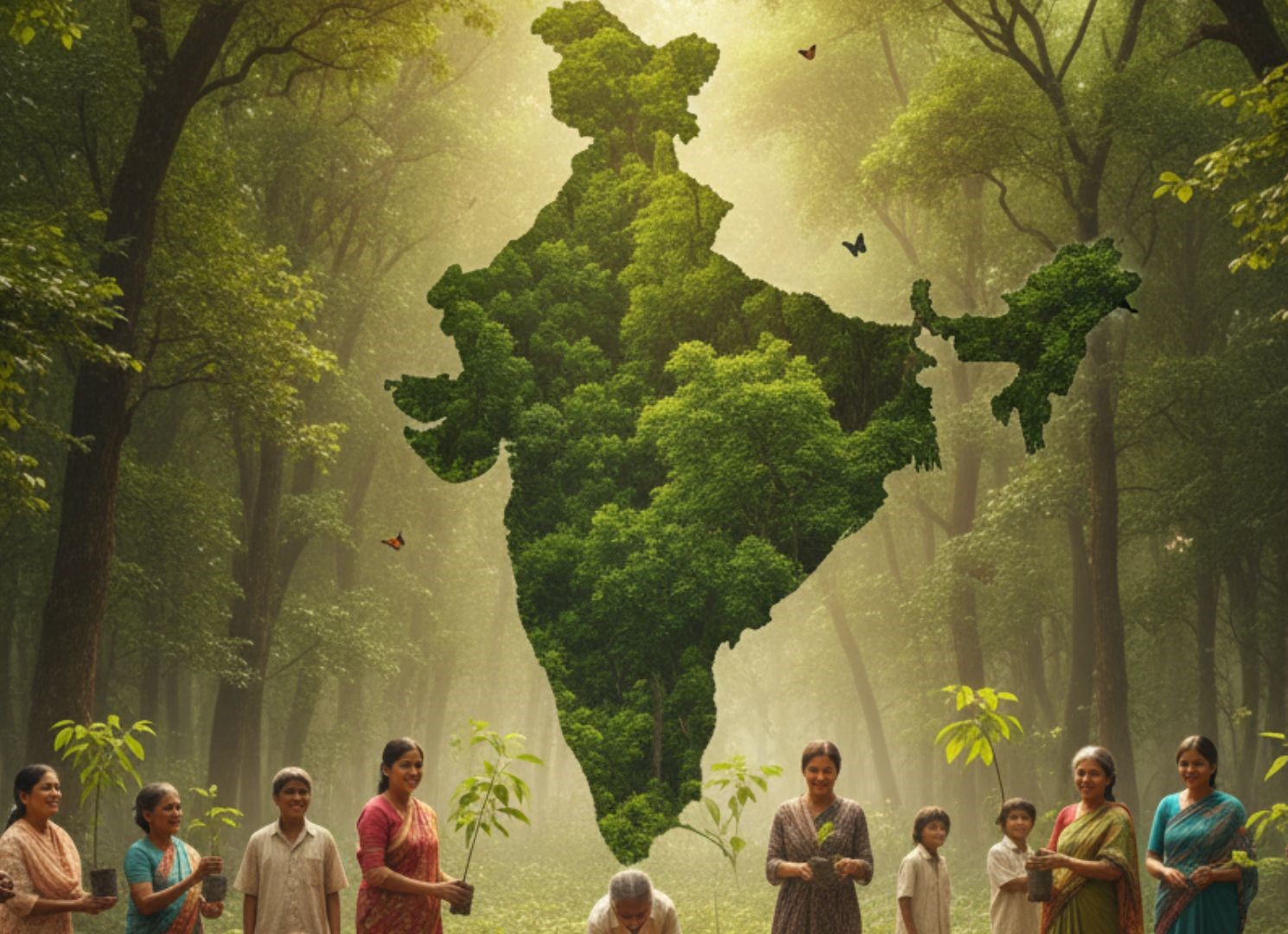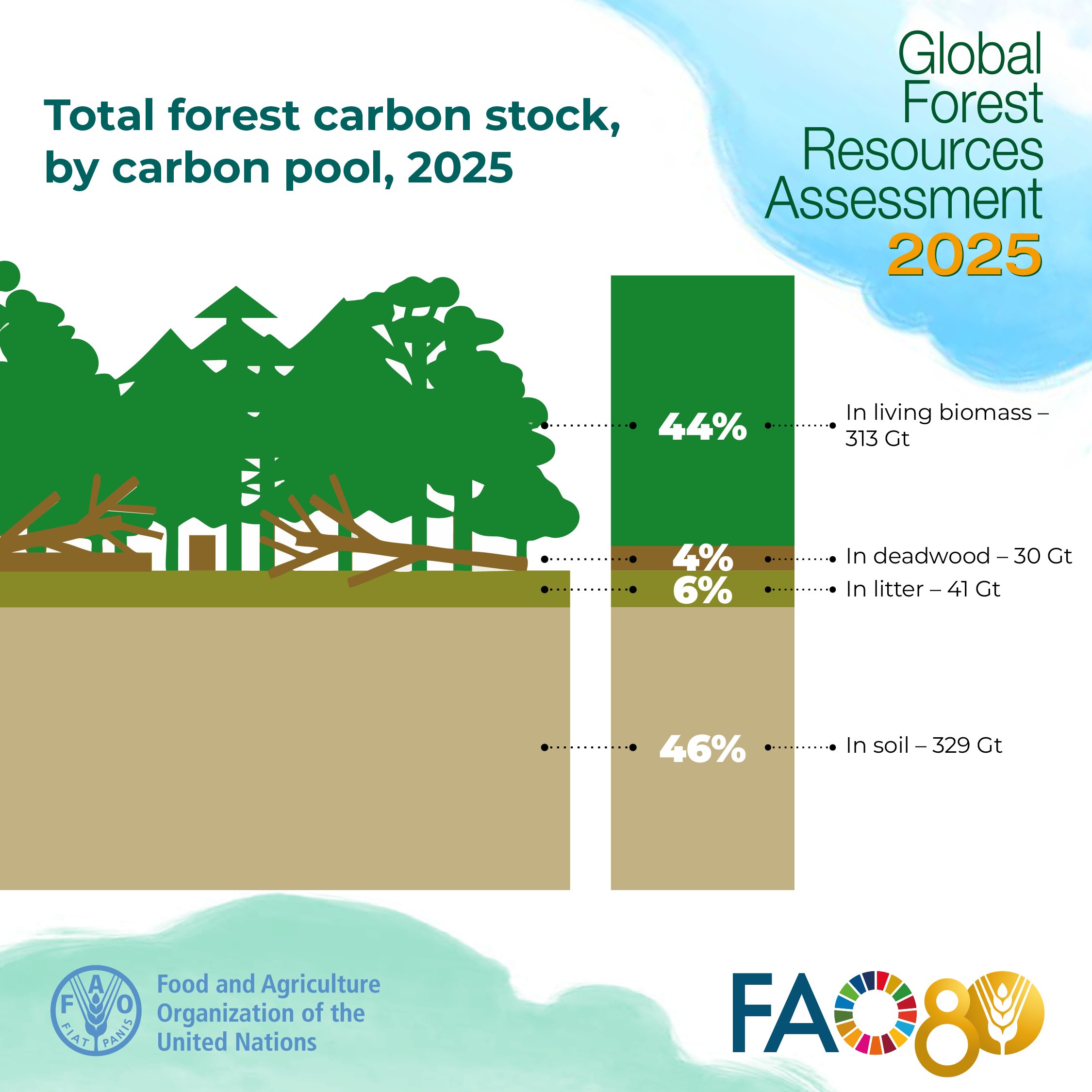Context:
India has achieved a significant global milestone in environmental conservation. According to the Global Forest Resources Assessment (GFRA) 2025 released by the Food and Agriculture Organization (FAO), India now ranks 9th in total forest area and continues to hold the 3rd position globally in net annual forest area gain. The report, published during the Global Forest Observations Initiative (GFOI) Plenary in Bali, reflects India’s sustained commitment to afforestation, sustainable forest management, and climate action.
About the GFRA 2025:
-
- The Global Forest Resources Assessment (GFRA) is a comprehensive evaluation published every five years by the FAO. It provides global data on forest area, condition, management, and use, based on official national reports. The assessment categorizes forests as naturally regenerating or planted, with further distinctions such as primary forests, plantation forests (like rubber), and other planted forests.
- The 2025 edition assessed global trends in deforestation, forest expansion, and carbon storage. It confirmed that the world’s total forest area stands at around 4.14 billion hectares, covering about 32% of Earth’s land surface, or roughly 0.5 hectares per person.
- The Global Forest Resources Assessment (GFRA) is a comprehensive evaluation published every five years by the FAO. It provides global data on forest area, condition, management, and use, based on official national reports. The assessment categorizes forests as naturally regenerating or planted, with further distinctions such as primary forests, plantation forests (like rubber), and other planted forests.
India’s Global Ranking and Contribution:
India’s performance in the GFRA 2025 marks a steady rise in its environmental efforts:
-
- 9th in Total Forest Area: India’s forest area stands at 72.74 million hectares, accounting for about 2% of global forest cover. This represents an improvement from the 10th position in the 2020 assessment.
- 3rd in Net Annual Forest Area Gain: India recorded a net annual increase of 191,000 hectares of forest between 2015 and 2025, behind only China and Russia.
- 5th among Global Carbon Sinks: Indian forests absorbed around 150 million tonnes of CO₂ per year during 2021–2025, underlining their critical role in global climate mitigation.
- 9th in Total Forest Area: India’s forest area stands at 72.74 million hectares, accounting for about 2% of global forest cover. This represents an improvement from the 10th position in the 2020 assessment.
These achievements stem largely from plantation drives, afforestation efforts, and sustainable forest management under national programs.
The Global Forest Picture:
Globally, the forest distribution is highly uneven:
-
- Europe has the largest forest area (25% of global total).
- South America has the highest proportion of forest cover (49% of its land area).
- Over half of global forest cover lies in just five countries — Russia, Brazil, Canada, the United States, and China.
- Some countries, such as Monaco and the Vatican City, have no forest cover at all.
- Europe has the largest forest area (25% of global total).
The report also notes a decline in the rate of deforestation, from 17.6 million hectares per year during 1990–2000 to about 10.9 million hectares per year during 2015–2025, showing progress toward sustainable management.
India’s Forest Profile:
According to the India State of Forest Report (ISFR) 2023:
-
- Total Forest Cover: 7,15,343 sq km, or 21.76% of India’s geographical area.
- Top States: Madhya Pradesh (77,073 sq km), Arunachal Pradesh (65,882 sq km), and Chhattisgarh (55,812 sq km).
- Mangrove Cover: About 4,992 sq km, concentrated in the Andaman & Nicobar Islands, Gujarat, Maharashtra, and West Bengal.
- Protected Areas: India has a strong biodiversity base with 106 national parks, 573 wildlife sanctuaries, 115 conservation reserves, and 220 community reserves.
- Total Forest Cover: 7,15,343 sq km, or 21.76% of India’s geographical area.
These figures highlight that India has not only expanded its green area but also strengthened biodiversity protection and eco-restoration.
India’s Strength in Planted Forests and Agroforestry:
-
- Bamboo Plantations
- India holds 11.8 million hectares of bamboo forests — about 39% of global bamboo area. The overall global bamboo resource stands at 30.1 million hectares, most of which is concentrated in Asia. India and China have been major contributors to the increase in bamboo forest area over the past three decades.
- Rubber Plantations
- India ranks 5th globally in rubber plantations, covering 831,000 hectares out of a global total of 10.9 million hectares. These plantations play a dual role — supporting livelihoods and contributing to carbon sequestration.
- Agroforestry Expansion
- Agroforestry — integrating trees with crops and livestock — has emerged as a key factor in India’s forest expansion. India and Indonesia together account for nearly 70% of the world’s agroforestry area, estimated at 55.4 million hectares. In Asia, nearly the entire agroforestry area (39.3 million hectares) comes from these two nations.
- This approach not only increases green cover but also enhances soil fertility, water retention, and income for rural households.
- Bamboo Plantations
Forest Carbon Trends (1990–2025):
The FAO’s analysis highlights encouraging carbon trends:
-
- Global forests acted as a net carbon sink, absorbing 3.6 billion tonnes of CO₂ annually between 2021 and 2025.
- Net emissions from forest conversion (deforestation) were 2.8 billion tonnes, leading to a net removal of 0.8 billion tonnes of CO₂ per year.
- Forest carbon sinks were strongest in Europe and Asia, removing 1.4 Gt and 0.9 Gt CO₂ per year respectively.
- Global forests acted as a net carbon sink, absorbing 3.6 billion tonnes of CO₂ annually between 2021 and 2025.
India’s share in this success is notable — its forests absorbed 150 Mt of CO₂ annually, reflecting the impact of sustained conservation and plantation efforts.
Key Government Initiatives Driving Forest Growth:
1. National Mission for a Green India (GIM)
Launched in 2014 under the National Action Plan on Climate Change (NAPCC), the Green India Mission aims to:
-
-
- Increase forest and tree cover by 5 million hectares, and improve the quality of another 5 million hectares.
- Enhance ecosystem services such as biodiversity, water, and carbon storage.
- Improve livelihood opportunities for around 3 million forest-dependent families.
- Increase forest and tree cover by 5 million hectares, and improve the quality of another 5 million hectares.
-
In recent years, GIM has expanded its focus to degraded landscapes in the Aravallis, Western Ghats, Himalayas, and mangroves, aligning with India’s broader restoration goals.
2. National Afforestation Programme (NAP)
This programme promotes ecological regeneration of degraded forests through a decentralized system involving:
-
-
- State Forest Development Agencies (SFDA)
- Forest Development Agencies (FDA) at the division level
- Joint Forest Management Committees (JFMCs) at the village level
- State Forest Development Agencies (SFDA)
-
It integrates local communities in afforestation and forest protection efforts.
3. Mission LiFE (Lifestyle for Environment)
A global movement launched by India, Mission LiFE focuses on individual and community action for sustainable living.
-
-
- The “MeriLiFE” portal encourages citizens to adopt eco-friendly habits.
- Campaigns like “Ek Ped Ma Ke Naam” promote emotional connections with tree planting.
- The “MeriLiFE” portal encourages citizens to adopt eco-friendly habits.
-
Mission LiFE was recognized by the UN Environment Assembly, strengthening India’s role as a thought leader in environmental stewardship.
4. Budgetary Boost for Environment Sector
In the 2025–26 Union Budget, the Ministry of Environment, Forest and Climate Change (MoEFCC) received an allocation of ₹3,412.82 crore, a 9% rise from the previous year. This includes ₹3,276.82 crore in revenue expenditure, supporting afforestation, forest restoration, and wildlife conservation programs.
Global Commitments and Future Targets:
India’s national climate pledge aims to:
-
- Create an additional carbon sink of 2.5–3 billion tonnes of CO₂ by 2030 through expanded forest and tree cover.
- Restore 26 million hectares of degraded land by 2030, as part of the Bonn Challenge and UNCCD commitments.
- Create an additional carbon sink of 2.5–3 billion tonnes of CO₂ by 2030 through expanded forest and tree cover.
Efforts under GIM, the Green Wall Project, and other afforestation initiatives will be central to achieving these goals.
Significance of Forests:
Forests are more than just carbon sinks — they are life-support systems.
-
- They filter and recharge groundwater, acting as natural purifiers.
- Roots stabilize soils and prevent landslides and floods.
- Mangroves buffer coastal storms and erosion.
- Forest ecosystems support over 80% of terrestrial biodiversity, including most of the world’s amphibians, birds, and pollinators.
- They sustain local communities by providing fuel, food, medicine, and livelihood resources.
- They filter and recharge groundwater, acting as natural purifiers.
Conclusion:
India’s rise to the 9th position globally in forest area and its continued 3rd rank in forest area gain demonstrate that sustained policy focus, community participation, and science-based afforestation yield tangible results. While global deforestation continues in several regions, India’s consistent expansion of forest cover and its ranking among the top global carbon sinks highlight its leadership in balancing development with ecological responsibility.
| UPSC/PCS Main Question: Evaluate the effectiveness of the Green India Mission (GIM) and National Afforestation Programme (NAP) in achieving India’s forest restoration and carbon sequestration goals. |








